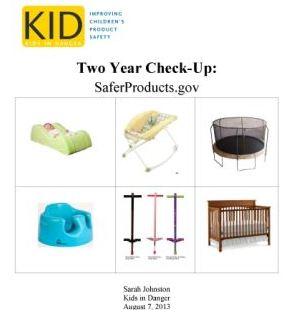
Congresswoman Schakowsky joined KID and others to mark the fifth anniversary of this landmark safety bill. She offers these insights.
This month we mark the fifth anniversary of the signing of the Consumer Product Safety Improvement Act (CPSIA), the most significant product safety reform since the creation of the Consumer Product Safety Commission in 1972.
I am proud to stand here today with Rep. Bobby Rush, as a cosponsor of his legislation which brought us needed reforms to the Consumer Product Safety Commission five years ago. I would also like to recognize Nancy Cowles and Kids in Danger, an organization whose efforts enabled us to be where we are today.
For far too long, the CPSC had been severely understaffed and ineffective in stopping dangerous products from making their way into our homes. Five years after CPSIA, the CPSC has made great strides to protect our children from dangerous cribs, lead-laden toys and untested designs.
As I said five years ago at the time of the signing, “Every child in America will be safer now that the bill has become law. The new law will make sure that our children are no longer used as test dummies because children’s toys and products will have to be pre-tested and meet higher standards.”
And through hard work and much oversight, the words are true today. We have gotten the lead out of toys; made sure children’s products are tested for safety before they are sold; created the first public database of product injury data; and provided funding and authority for the US Consumer Product Safety Commission (CPSC) to vigorously enforce consumer protection laws and keep dangerous products out of our ports, stores and homes. Together those provisions have remade our product safety system.
I am particularly proud of the durable infant and toddler products rules that have saved countless lives since the CPSIA was enacted. Those provisions stem from a bill I sponsored since 2001 named after Danny Keysar, whose parents founded Kids in Danger after his needless death.
“Danny’s Law” requires strong standards for infant and toddler durable products – cribs, strollers and high chairs for example – that families depend on for the care of their children. It also facilitated easier product registration by mail and over the internet so that parents can more easily learn of a recalled product. And it required that those older cribs that don’t meet the new standard would be removed from our child care facilities.
Prior to the CPSIA, dozens of babies were killed when poorly-made and designed cribs literally fell apart in use – entrapping babies against detached drop-sides, failing mattress supports and broken side slats. Just from 2007-2011, more than 11 million cribs were recalled. Because of Danny’s Law, the world’s toughest crib standard went into effect in 2011 and today’s families and caregivers can be sure the crib they are buying will keep their baby safe.
Along with tough federal standards, outreach and education are vitally important. Groups such as Illinois Action for Children and facilities such as the Carole Robertson Center for Learning are helping to address that need, educating caregivers and helping to replace all those older cribs. I applaud your hard work and dedication to this issue.
As a mother and a grandmother, I’m proud that we were able to work together to protect our children from unsafe products by creating the strongest product safety reforms in recent history.
As we move forward, we need to keep our eye on the ball and make sure that the improvements we’ve worked so hard to accomplish remain intact. I will continue fighting for adequate funding, resources, and regulations to ensure the CPSC can continue to do its critical job, and I know I can count on all of you to do the same.


